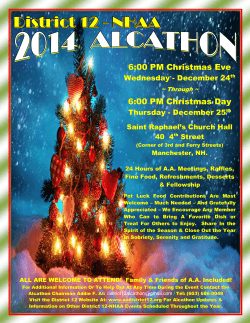
Market Analysis for Commuter Ferry Service on
Northern Virginia Regional Commission Market Analysis for Commuter Ferry Service on the Occoquan, Potomac, & Anacostia Rivers Lorem ipsum dolor sit amet Prepared by: October 16, 2012 In association with: •Foursquare Integrated Transportation Planning •Gallop Corporation •WB&A Market Research •CJI Research •Shapiro Transportation Consulting • HR&A Advisors Today’s Meeting Introduce the Study Introduce the consulting team Project Outline What is happening in other places We have some questions for you Project Team NVRC Peggy Tadej, Project Manager Commuter Ferry Stakeholders Group Tim Payne, Principal Consulting Team Project Manager Nelson\Nygaard David Miller, Senior Planner Deputy Project Manager Foursquare ITP Stakeholder Communications Presentations & Quality Control Tim Payne Nelson\Nygaard Tim Payne Nelson\Nygaard Lora Byala Foursquare ITP Lora Byala Foursquare ITP Karina Ricks Nelson\Nygaard Karina Ricks Nelson\Nygaard Research, Corridor Evaluation Process, Recommendations, Report Writing David Miller Foursquare ITP Stephanie Wright Nelson\Nygaard Andrew Zalewski Foursquare ITP Mike Eiseman Nelson\Nygaard Market Research Kevin Pullis WB&A Steven Markenson WB&A Demand & Ridership Modeling Eric Ho, PH.D, P.E., Gallop Corp. Expert Advisors Hugh Clark, Market Research CJI Research Phil Shapiro, Modeling Shapiro Transportation Consulting Eric Rothman, Development Economics HR&A Advisors Project Process 1. Kick-off meeting -- September 19, 2012 Stakeholder interviews –- September-October 2012 2. Criteria and methodology for terminal and corridor selection -- October-December 2012 3. Market analysis to determine demand: Modeling work -- December-January, 2013 Market research -- February-March, 2013 4. Preliminary service model -- April, 2013 5. Draft and Final Reports -- May-June, 2013 Presentations –- July–August, 2013 Outreach Purpose – Project progress review by steering committee – Gain stakeholder understanding, study support – Understand needs of stakeholders’ different perspectives How – Scheduled steering committee meetings – Group interviews with objective discussion guide – Share results with broad audience Anticipated Meetings Of Steering Committee September 19 – Kick-off Mid-November – Review Terminal/Corridor Selection Criteria and List to be screened Mid-December – Review results of screening a preliminary top five corridors for study Late February – Review results of modeling effort, midpoint status report on market research Late April – Review market research and preliminary service model results Late June – Final report presentation Criteria and Methodology for Terminal and Corridor Selection Origin/Destination Potential Identification Terminal Sites Size of commute market – home end Size of commute market – work end Available landing sites Planned development around the site Intermodal transfer available Corridors – Criteria development Trips between origin-destination pairs Relative travel time Travel time reliability Apply the criteria RESULT: Screened and ranked list of potential ferry origins and destinations and corridors Market Analysis Top Five Corridors Evaluation – Model development and deployment – Market research development and deployment Demand and Service Model Cycle Basic Service/Fare/Time assumptions Demand Model and Survey results Revise a key factor(s) Feasible Alternative defined Examine results ridership/operating cost/farebox return/capital costs NO Values in expected ranges for feasible service? WHAT IS HAPPENING IN OTHER PLACES? Puget Sound Multiple ferry operators, private and public Commuter ferries are all public and are a mix of car/passenger and passenger only vessels. Terminals are a combination of simple to complex Daily ferry commuters on Puget Sound exceeds 20,000 per day. San Francisco Bay Multiple operators – all passenger only Commuter ferries and tourism ferries, some dual purpose. Integrated information system Variety of funding sources – most notable is resurgence of ferries following closure of earthquake damaged Bay Bridge and birth of WETA. Boston Combination of commuter and visitor type services. Well established terminals on Boston Waterfront Service from Boston waterfront to Logan Airport Combination of public and privately funded operations Some local townships to the north also operate vessels to the Boston waterfront. New York Combination of commuter, water taxi, and visitor type services Most extensive network of privately operated ferries in the US. Two major private operators, NY Waterways and Seastreak, one major public operator Staten Island Ferry Terminals developed as public infrastructure Specialized bus transit systems to distribute passengers in Manhattan Your Turn to Talk Key transportation needs and challenges Interest in ferry service Land side access Factors that will attract ridership Concerns about ferry service QUESTIONS? Tim Payne 1402 Third Avenue Suite 1200 Seattle, WA 98101 Office: (206) 357-7524 tpayne@nelsonnygaard.com NELSON\NYGAARD CONSULTING ASSOCIATES © 2011
© Copyright 2025










